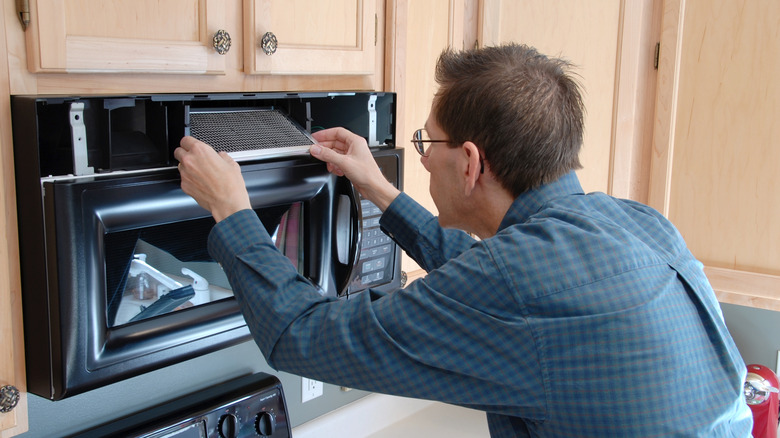How Often Should You Clean Your Microwave Filter?
The microwave is one of those kitchen appliances we use all the time, perhaps to reheat mashed potatoes, yesterday's takeout, or even cooking steak, but it often gets overlooked when it comes to cleaning, especially one out-of-sight component: the filter. Unlike countertop microwaves, which don't require filters, over-the-range microwaves do, as they double as ventilation systems for your stove. Usually found on the underside of your microwave, its role is to trap grease and food particles, so they don't recirculate into the air or build up, which would leave behind lingering odors and negatively impact how your microwave functions.
So how often should you clean this important component? To find out, Food Republic consulted Vanessa Ruiz, professional organizer at Sparkly Maid San Antonio. Her advice? "Clean microwave grease filters every three to six months, depending on frequency of cooking and microwave ventilation use. If you cook frequently or use your stovetop heavily, you may need to clean the filter on a monthly basis to reduce possible buildup of grease or oils. Charcoal filters in non-vented microwaves should be replaced instead of [cleaned], typically every six months, or sooner if smells stick around," Ruiz told us.
Over-the-range microwaves come in two types: vented and non-vented. Vented microwaves exhaust air outside the home, whereas non-vented microwaves push the filtered air back into the kitchen. Both types contain a grease filter, and some vented and most non-vented microwaves also include a charcoal filter that absorbs odors to prevent them from lingering in your kitchen.
Signs that your microwave filter is due a clean
When determining if your microwave filter needs cleaning, there are several warning signs to watch out for. "Check for signs of visible grease accumulation, discoloration (yellow or brown stains), or a sticky[,] unpleasant odor from the microwave," Vanessa Ruiz told us. A greasy buildup often appears as a shiny film coating the filter, leaving behind a sticky, unpleasant residue when touched. In serious cases, it may even be dripping grease. You can also tell if your filter is no longer effectively trapping grease particles by wiping down the interior of the microwave with a tissue. If you notice dark grease stains, it's probably time to clean out your filter.
Another telling sign that your microwave filter is due a clean is by keeping an eye on its performance. According to Ruiz, "Poor ventilation, inconsistent microwave operation, or a loud fan could also be signs of a clogged filter." As grease accumulates, it restricts airflow and forces the microwave to work harder, which can lead to performance issues over time. You may notice subtle issues like lingering odors and excessive smoke and steam, or more serious ones like overheating caused by reduced airflow (which can also lead to uneven cooking). While a dirty filter can usually be cleaned, "if the filter is damaged or has cracks or holes, the filter must be replaced immediately for safe operation," Ruiz advised. A damaged filter not only impacts the quality of your cooking but also poses a serious fire risk. In this case, they can be easily replaced.
How to clean your grease filters
According to Vanessa Ruiz, how often you clean your grease filter "generally depends on how often you cook and the types of food you cook." Frequently cooking food that produces a lot of grease — like bacon, sausages, or eggs — will naturally require you to clean your grease filter more often than if you cook with lighter foods. For a general rule of thumb, "refer to the manufacturer's manual for how often to clean the grease filter," Ruiz advised.
When it comes to cleaning your grease filter, be aware that water and oil don't mix, and since grease is a combination of fats and oils, rinsing with water alone won't do anything. To deep-clean your grease filter, soak it in a bath of hot, soapy water. For extra cleaning power, add a tablespoon of baking soda and white vinegar to create an abrasive solution to lift stubborn grease stains. Let the filter soak for about 30 minutes, and then lightly scrub away any remaining grease residue. Rinse thoroughly, dry completely, and your filter should look as good as new!
While vented microwaves are simple enough, "non-vented microwaves typically have charcoal filters that trap odors, while some may have a hood, or an underlying attachment, that can often use a metropolis filter or grease filter," Ruiz told us. Charcoal filters are made up of activated carbon, which has millions of tiny holes to trap odors, grease, and smoke. Once these pores are clogged and the filter's efficiency is reduced, washing with water and soap will only further clog and damage these pores. This is why "charcoal filters cannot be washed and need to be replaced," Ruiz explained.



